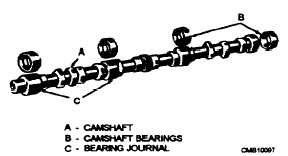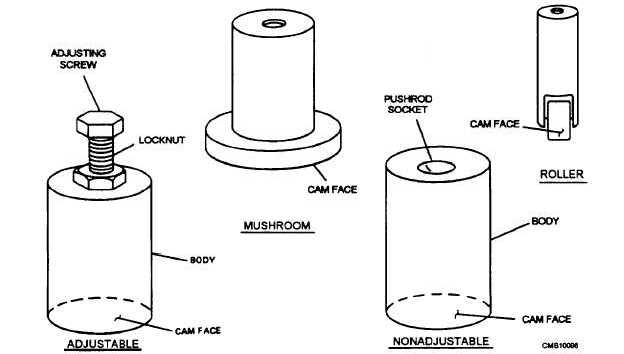
Figure 3-46. - Camshaft and bushings.
Camshaft
The camshaft provides for the opening and closing of the engine valves. The camshaft (fig. 3-46) is enclosed in the engine block. It has eccentric lobes (cams) ground on it for each valve in the engine. As the camshaft rotates, the cam lobe moves up under the valve tappet, exerting an upward thrust through the tappet against the valve stem or the pushrod. This thrust overcomes the valve spring pressure as well as the gas pressure in the cylinder, causing the valve to open. When the lobe moves from under the tappet, the valve spring pressure reseats the valve.
On L-, F-, or I-head engines, the camshaft is located to one side and above the crankshaft, while in V-type engines, it is located directly above the crankshaft On the overhead camshaft engine, the camshaft is located above the cylinder head
The camshaft of a four-stroke-cycle engine turns at one half of engine speed. It is driven off the crankshaft through timing gears or a timing chain. (The system of camshaft drive is dismissed later in this chapter.) In a two-stroke-cycle engine, the camshaft must turn at the same speed as the crankshaft, so each valve opens and closes once in each revolution of the engine.
In most cases, the camshaft does more than operate the valve mechanism. It may have external cams or gears that operate the fuel pumps, the fuel injectors, the ignition distributor, or the lubrication pump.
Camshafts are supported in the engine block by journals in bearings. Camshaft bearing journals are the largest machined surfaces on the shaft. The bearings are made of bronze and are bushings, rather than split bearings. The bushings are lubricated by oil circulating through drilled passages from the crankcase. The stresses on the camshaft are small; therefore, the bushings are not adjustable and require little attention. The camshaft bushings are replaced only when the engine requires a complete overhaul.
Followers
Camshaft followers are part of the valve actuating mechanism that contacts the camshaft. You will hear them called valve tappets or valve lifters. The bottom surface is hardened and machined to be compatible with the surface of the camshaft lobe. There are two basic type of followers - mechanical and hydraulic.
MECHANICAL (or solid) tappets (fig. 3-47) are simply barrel-shaped pieces of metal. When used in flathead engines, they have an adjusting screw mechanism to set the clearance between the tappets and the valve stems. Mechanical tappets may also come with a wider bottom surface. These are called

Figure 3-47. - Mechanical tappets
Continue Reading